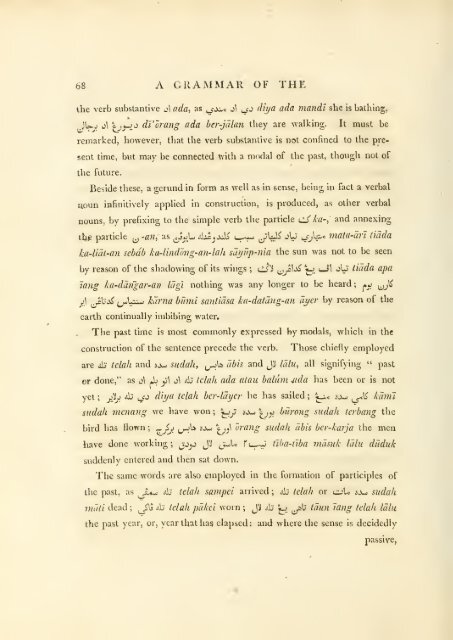A grammar of the Malayan language, with an introduction and praxis..
A grammar of the Malayan language, with an introduction and praxis..
A grammar of the Malayan language, with an introduction and praxis..
Create successful ePaper yourself
Turn your PDF publications into a flip-book with our unique Google optimized e-Paper software.
68 A GRAMMAR OF THE<br />
<strong>the</strong> verb subst<strong>an</strong>tive ^\ ada, as ^x^ J\ i_jj<br />
dij/a ada m<strong>an</strong>di she is bathing,<br />
.JU-.> J\ f j_H'^ di'orayig ada ber-jdl<strong>an</strong> <strong>the</strong>y are -walking. It must be<br />
remarked, however, that <strong>the</strong> verb subst<strong>an</strong>tive is not confined to <strong>the</strong> pre-<br />
sent time, but may be connected <strong>with</strong> a modal <strong>of</strong> <strong>the</strong> past, though not <strong>of</strong><br />
<strong>the</strong> future.<br />
Beside <strong>the</strong>se, a gerund in form as well as in sense, being in fact a verbal<br />
uoun infinitively applied in construction, is produced, as o<strong>the</strong>r verbal<br />
nouns, by prefixing to <strong>the</strong> simple verb <strong>the</strong> particle cS ka-, <strong>an</strong>d <strong>an</strong>nexing<br />
<strong>the</strong> particle ^ -<strong>an</strong>,zs ^^^L iki^jJi ^,^ ^j\^ jLi' ljJ^^<br />
matu-dn tidda<br />
ha-lidl-<strong>an</strong> sebdb ka-Undmg-ayi-lah sdyup-nia <strong>the</strong> sun was not to be seen<br />
by reason <strong>of</strong> <strong>the</strong> shadowing <strong>of</strong> its wings ; cJ^ uj^"^ 't*. *—*^ '^^ tidda apa<br />
lajig ka-ddngar-aii Idgi nothmg was <strong>an</strong>y longer to be heard; j»^ ^^JS,<br />
j)\ ^^'^ ^^ri- kdnia bumi s<strong>an</strong>tidsa ka-datdng-<strong>an</strong> dyer by reason <strong>of</strong> <strong>the</strong><br />
earth continually imbibing water.<br />
The past time is most commonly expressed by modals, which in <strong>the</strong><br />
construction <strong>of</strong> <strong>the</strong> sentence precede <strong>the</strong> verb. Those chiefly employed<br />
are ^ telah <strong>an</strong>d is^ sudah, ^jJjt, dbis <strong>an</strong>d J^ Idlu, all signifying " past<br />
or done," as J\ Jj yi\ j\ .jIj telah ada atau balum 4ida has been or is not<br />
yet ; Jij i^ ^d diya telah ber-ldt/ej- he has sailed ; 'j_i< iju- ^\^ kdmt<br />
sudah men<strong>an</strong>g we have won ; ^y<br />
bird has flown ; ^^j ^jJa sjw: \j^<br />
have done working; jjjj J1<br />
suddenly entered <strong>an</strong>d <strong>the</strong>n sat down.<br />
^j^j 'c,jj burong sudah terb<strong>an</strong>g <strong>the</strong><br />
or<strong>an</strong>g sudah dbis ber-katja <strong>the</strong> men<br />
^^U r(_->J tiha-tJba mdsiik Idlu duduk<br />
The same words are also employed in <strong>the</strong> formation <strong>of</strong> participles <strong>of</strong><br />
<strong>the</strong> past, as ^J,^

















